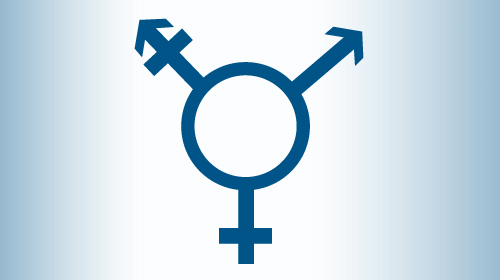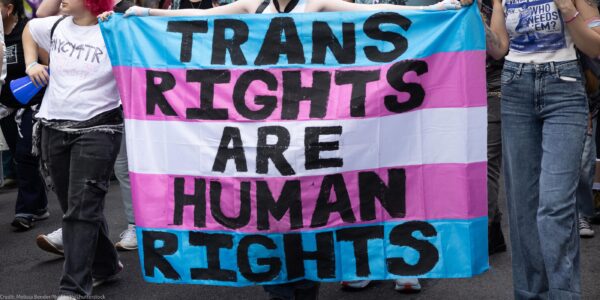
Like many Americans, Asher Schor is excited to vote this coming November. Asher was born and raised in Pittsburgh, works at a public interest law firm, and feels more motivated than ever to participate in the electoral process. But Asher is one of thousands of transgender Americans whose driver’s license and passport do not reflect his or her true gender identity. Asher received his photo ID before his transition and the official sex listed still reads “Female.” He recently joined the ACLU of Pennsylvania’s lawsuit against a new and particularly onerous voter ID law, and I had a chance to discuss how the new law will impact him at the polls this November. This LGBT Pride Month, it’s important to examine the ways that voter suppression efforts, like newly-enacted photo ID laws, will have a disproportionately harmful impact on those who are transgender.
In recent years, state houses across the country have passed more laws making casting a ballot increasingly difficult. States have used different tactics in in their efforts to restrict access to the ballot, but many have passed voter identificationlaws. Stopping voter fraud is the posited rationale for these laws. However, voter ID laws across the country impose onerous burdens on many voters to fix a problem that doesn’t exist. There is much more evidence that qualified voters are disfranchised by these measures than there is evidence of in person impersonation fraud – the only type of fraud a voter ID might address.
In some states, voters can only cast a ballot if they display a valid photo identification, from a very short list of acceptable IDs, at their polling place. While the requirement at first glance seems simple, a recent study by the Brennan Center for Justice demonstrated the devastating impact these laws will have on minority, voters with disabilities, elderly, young and low-income voters. As many as five million eligible voters face disfranchisement this election cycle. State houses are enacting needlessly restrictive laws that will prevent or discourage millions of Americans from exercising their most basic civil right.
In addition, transgender voters face unique challenges in complying with recent voter ID laws. According to a recent study by the Williams Institute at the UCLA School of Law, over 25,000 otherwise eligible transgender voters could be turned away at their polling places come November. The most pressing problem is the potential discrepancy between a voter’s gender identity and his or her designated sex on state-issued identification. The National Transgender Discrimination Survey (NTDS) found over 40 percent of transgender men and women do not have an ID that accurately reflects their gender. Asher is concerned that the discrepancy between his identification documents and his gender identity could lead to confusion and a higher level of needless and potentially embarrassing scrutiny from poll workers. “I am certainly expecting to be scrutinized,” Asher says, “and possibly even accused of having a fake ID.”
Transgender men and women often face difficult hurdles when attempting to change their state-issued documentation to reflect their lived gender. As a paralegal, Asher believes he has a fairly good understanding of the law, but admits changing one’s documentation can be confusing. “It’s a huge process,” he says, “because you have to change everything all at once.” For Asher, the decision to change his documentation is primarily about timing. He says he wants to wait until his physical transition is further along before undertaking the complicated legal process of changing his documentation.
In addition to the bureaucratic and legal hurdles, transgender individuals face discrimination and harassment at staggering levels on a regular basis. The NTDS reported 22 percent of transgender respondents had been denied equal treatment or had experienced harassment by government officials when presenting incongruent ID. “Showing identification is really uncomfortable for me,” Asher said. “There is always that fear when I pull out my ID.” As Asher’s transition continues, he will display more masculine traits, such as facial hair, that will make the process of showing his ID even more uncomfortable. “I’m worried that in order to vote without being discriminated against,” he said, “I’ll have to present at the polls in a way that doesn’t conform with my identity.” No state should force its citizens to make such a choice.
Transgender voters are just one group facing disfranchisement this election. Thousands of transgender voters could be turned away at the polls; untold more will stay home rather than risk discrimination or harassment from polling officials. Asher is still eager to vote, in spite of the potential for harassment. “This law made me really angry that my state would erect more barriers to voting,” he said. “It gave me the kick in the pants I needed to get more involved and excited about voting this fall.”
The stakes could not be higher in this coming election. The injustice facing millions of voters is offensive to the very spirit of democracy. The Supreme Court has described the right to vote as a civil right “of the most fundamental significance under our constitutional structure,” since the ability to cast a ballot is “preservative of other basic civil and political rights.” In other words, voting is the means by which citizens maintain and protect their other rights. With the start of LGBT Pride Month, it’s crucial to recognize that voter suppression is and will continue to be an LGBT issue.
Learn more about LGBT rights: Sign up for breaking news alerts, follow us on Twitter, and like us on Facebook.
Stay informed
Sign up to be the first to hear about how to take action.
By completing this form, I agree to receive occasional emails per the terms of the ACLU's privacy statement.
By completing this form, I agree to receive occasional emails per the terms of the ACLU's privacy statement.


